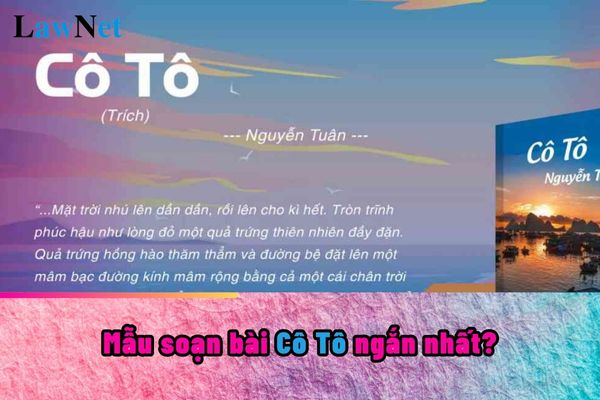What are guidelines on preparing the lesson "Cô Tô" for students in Vietnam? What are detailed competencies required for lower secondary school students in Vietnam?
What are guidelines on preparing the lesson "Cô Tô" for students in Vietnam?
"Cô Tô" is one of the documents that students will study in the grade 6 Literature program.
Grade 6 students can refer to the following guidelines on preparing the lesson "Cô Tô":
|
Lesson Plan Cô Tô *Literary Devices |
*Note: The above information is for reference only./.

What are guidelines on preparing the lesson "Cô Tô" for students in Vietnam? What are detailed competencies required for lower secondary school students in Vietnam? (Image from the Internet)
What are the general competencies of grade 6 students in Vietnam?
Pursuant to the regulations of the General Education Program issued under Circular 32/2018/TT-BGDDT, it clearly states 5 qualities and 10 core competencies of students, among which the general competencies for lower secondary school students include:
- Autonomous and self-learning abilities
- Communication and cooperation abilities
- Problem-solving and creative abilities
What are detailed competencies required for lower secondary school students (grade 6 students) in Vietnam?
Based on Section 9 of the General Education Program issued under Circular 32/2018/TT-BGDDT, the requirement for general competencies of lower secondary school students are as follows:
| Competency | Lower secondary level |
| Autonomous and Self-Learning Ability | |
| Self-reliance | Able to actively and positively perform personal tasks in learning and life; does not agree with dependent or reliant behavior. |
| Self-assertion and protection of legitimate rights and needs | Understands personal rights and needs; can distinguish between legitimate and illegitimate rights and needs. |
| Self-regulation of feelings, attitudes, and behavior | - Recognizes one's feelings and emotions and understands their influence on behavior. - Can control feelings and emotions to behave appropriately in learning and life; refrains from wasteful spending, mischievousness, or wrongdoing; does not encourage or engage in bad activities. - Able to persist in executing study and work plans. |
| Adaptability to life | - Flexibly applies learned knowledge, skills, or existing experience to solve problems in new situations. - Remains calm in unexpected changes in circumstances; persists through difficulties to complete planned necessary tasks. |
| Career orientation | - Recognizes personal interests and abilities. - Understands the role of economic activities in social life. - Recognizes some key information about local industries, main production fields; chooses an appropriate development direction after secondary school. |
| Self-study and self-improvement | - Sets personal learning goals and strives to achieve them. - Can devise and implement study plans; selects appropriate study materials; records information selectively using outlines, concept maps, tables, keywords; takes lecture notes based on main points. - Recognizes and corrects personal errors and limitations when receiving feedback from teachers, peers; proactively seeks support when facing difficulties in learning. - Trains and overcomes personal limitations towards social values. |
| Communication and Cooperation Ability | |
| Determines communication objectives, content, means, and attitudes | - Sets communication objectives and understands the importance of goal-setting before engaging. - Understands communication content and methods must align with objectives and knows how to apply them effectively. - Comprehends texts on simple life, scientific, cultural topics that use language combined with diagrams, data, formulas, symbols, images. - Uses language with diagrams, data, formulas, symbols, images to present information, ideas, and discuss simple academic, life, or artistic issues. - Listens and responds positively in communication; recognizes the context and participant characteristics and attitudes. |
| Establishes and develops social relations; adjusts and resolves conflicts | - Knows how to establish, maintain, and develop relationships with community members (relatives, friends, neighbors,...). - Recognizes conflicts between oneself and others or among others; is willing to reconcile and knows how to reconcile conflicts. |
| Determines the objectives and methods of cooperation | Proactively suggests cooperation objectives when assigned; knows which tasks are best accomplished through group collaboration. |
| Determines personal responsibilities and activities | Understands group tasks; assesses personal ability and voluntarily takes on suitable work. |
| Assesses collaborators' needs and capabilities | Assesses aspirations and capabilities of group members to propose cooperation organization methods. |
| Organizes and persuades others | Proactively and exemplarily completes assigned tasks, suggests adjustments and promotes common activities; humbly learns from group members. |
| Evaluates cooperation activities | Comments on strengths, weaknesses of oneself, each group member, and the whole group in tasks. |
| International integration | - Has basic understanding of relationships between Vietnam and some countries globally and international organizations frequently interacting with Vietnam. - Actively participates in international integration activities suitable to oneself and the characteristics of the school or locality. |
| Problem-Solving and Creative Ability | |
| Recognizes new ideas | Identifies and clarifies new information and ideas; able to analyze, summarize related information from various sources. |
| Identifies and clarifies the problem | Analyzes learning situations; identifies and articulates problematic situations in learning. |
| Forms and implements new ideas | Discovers new, positive elements in others' opinions; forms ideas based on given information sources; proposes improvements or alternative solutions when old ones are inadequate; compares and comments on proposed solutions. |
| Proposes and chooses solutions | Identifies and explores information related to the problem; proposes solutions to solve the problem. |
| Designs and organizes activities | - Develops activity plans with appropriate objectives, content, and forms. - Knows how to assign tasks fitting group participants' skills. - Evaluates suitability of plans, solutions, and their execution. |
| Independent thinking | Asks different questions about an object, phenomenon, issue; listens attentively and accepts information, ideas with consideration; cares about evidence when evaluating objects or events; assesses problems under diverse perspectives. |

